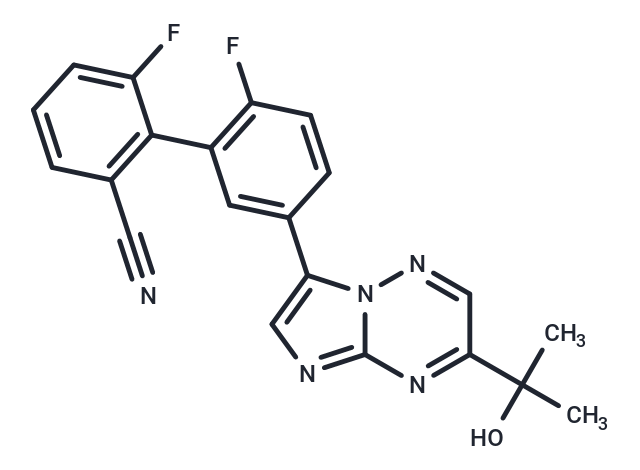Powder: -20°C for 3 years | In solvent: -80°C for 1 year


TPA-023B is an orally active and high-affinity agonist of the GABAA receptor α2/α3 subtype (Kis: 0.73 nM/2 nM) partial and an antagonist α1 subtype (Ki: 1.8 nM), has non-sedating anxiolytic-like properties.

| Pack Size | Availability | Price/USD | Quantity |
|---|---|---|---|
| 25 mg | 6-8 weeks | $ 1,400.00 | |
| 50 mg | 6-8 weeks | $ 1,820.00 | |
| 100 mg | 6-8 weeks | $ 2,500.00 |
| Description | TPA-023B is an orally active and high-affinity agonist of the GABAA receptor α2/α3 subtype (Kis: 0.73 nM/2 nM) partial and an antagonist α1 subtype (Ki: 1.8 nM), has non-sedating anxiolytic-like properties. |
| In vitro | TPA-023B has high affinity for α5 subtype with Ki of 1.1 nM of human recombinant GABAA receptor, but over 1500-fold lower for the α4- and α6 containing subtypes (Ki > 1000 nM). In different regions of the CNS,TPA-023B also has a comparable affinity for native rat GABAA receptors (Ki of 0.32-0.99 nM in cerebellum, spinal cord and frontal cortex). TPA-023B antagonizes the ability of chlordiazepoxide to potentiate the GABA EC20-induced current in cells expressing the α1 subtype. More specifically, 3 μM chlordiazepoxide potentiates the GABA EC20 current by 105% and this effect could be reduced to 8% in the presence of 100 nM TPA-023B. |
| In vivo | Measured using an in vivo [3H]flumazenil binding assay,TPA-023B gives dose- and time-dependent occupancy of rat brain GABAA receptors, with 50% occupancy corresponding to a respective dose and plasma drug concentration of 0.09 mg/kg and 19 ng/mL. TPA-023B is anxiolytic in rodent and primate (squirrel monkey) models of anxiety (elevated plus maze, fear-potentiated startle,up to doses (10 mg/kg) corresponding to occupancy of greater than 99%. |
| Molecular Weight | 391.37 |
| Formula | C21H15F2N5O |
| CAS No. | 425377-76-0 |
Powder: -20°C for 3 years | In solvent: -80°C for 1 year
You can also refer to dose conversion for different animals. More
bottom
Please see Inhibitor Handling Instructions for more frequently ask questions. Topics include: how to prepare stock solutions, how to store products, and cautions on cell-based assays & animal experiments, etc.
TPA-023B 425377-76-0 Others TPA 023B TPA023B inhibitor inhibit
